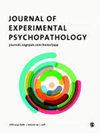Male body dissatisfaction, eating disorder symptoms, body composition, and attentional bias to body stimuli evaluated using visual search
IF 1.9
4区 医学
Q4 PSYCHIATRY
引用次数: 11
Abstract
This study investigated the relationship between body dissatisfaction, eating disorder symptoms, and attentional bias to images of male bodies using a compound visual search task. Sixty-three male participants searched for a horizontal or vertical target line among tilted lines. A separate male body image was presented within proximity to each line. Overall, search times were faster when the target line was paired with a muscular or obese body and distractor lines were paired with bodies of average muscularity and body fat (congruent trials) than on neutral trials, in which only average muscularity and body fat images were shown. Attentional bias for muscular bodies was correlated with muscle dissatisfaction, eating restraint, and shape concern, and attentional bias for obese bodies was correlated with eating restraint. For incongruent trials, in which a single muscular or obese body was paired with a distractor line, search times were indistinguishable from neutral trials. Unexpectedly, we found a negative association between search times and both body fat dissatisfaction and eating disorder symptoms in conditions where obese bodies were paired with distracting stimuli. This result implicates a potential role for attentional filtering and/or avoidance of obese bodies in predicting body fat dissatisfaction and eating disorder symptomology.男性身体不满意、饮食失调症状、身体组成和对身体刺激的注意偏向使用视觉搜索进行评估
本研究使用复合视觉搜索任务调查了身体不满、饮食失调症状和对男性身体图像的注意偏差之间的关系。63名男性参与者在倾斜的线中寻找水平或垂直的目标线。在每条线附近呈现一个单独的男性身体图像。总的来说,当目标线与肌肉或肥胖的身体配对,而分心线与平均肌肉和体脂的身体配对(一致性试验)时,搜索时间比中性试验快,在中性试验中,只显示平均肌肉和体脂图像。肌肉身体的注意偏倚与肌肉不满意、饮食限制和形状关注相关,肥胖身体的注意偏倚与饮食限制相关。在不一致的试验中,单个肌肉或肥胖的身体与干扰线配对,搜索时间与中性试验没有区别。出乎意料的是,我们发现在肥胖的身体与分散注意力的刺激配对的情况下,搜索时间与身体脂肪不满和饮食失调症状之间存在负相关。这一结果暗示了注意过滤和/或避免肥胖身体在预测体脂不满和饮食失调症状方面的潜在作用。
本文章由计算机程序翻译,如有差异,请以英文原文为准。
求助全文
约1分钟内获得全文
求助全文
来源期刊

Journal of Experimental Psychopathology
Medicine-Psychiatry and Mental Health
CiteScore
2.00
自引率
0.00%
发文量
19
审稿时长
11 weeks
期刊介绍:
The Journal of Experimental Psychopathology (EPP) is an open access, peer reviewed, journal focused on publishing cutting-edge original contributions to scientific knowledge in the general area of psychopathology. Although there will be an emphasis on publishing research which has adopted an experimental approach to describing and understanding psychopathology, the journal will also welcome submissions that make significant contributions to knowledge using other empirical methods such as correlational designs, meta-analyses, epidemiological and prospective approaches, and single-case experiments.
 求助内容:
求助内容: 应助结果提醒方式:
应助结果提醒方式:


